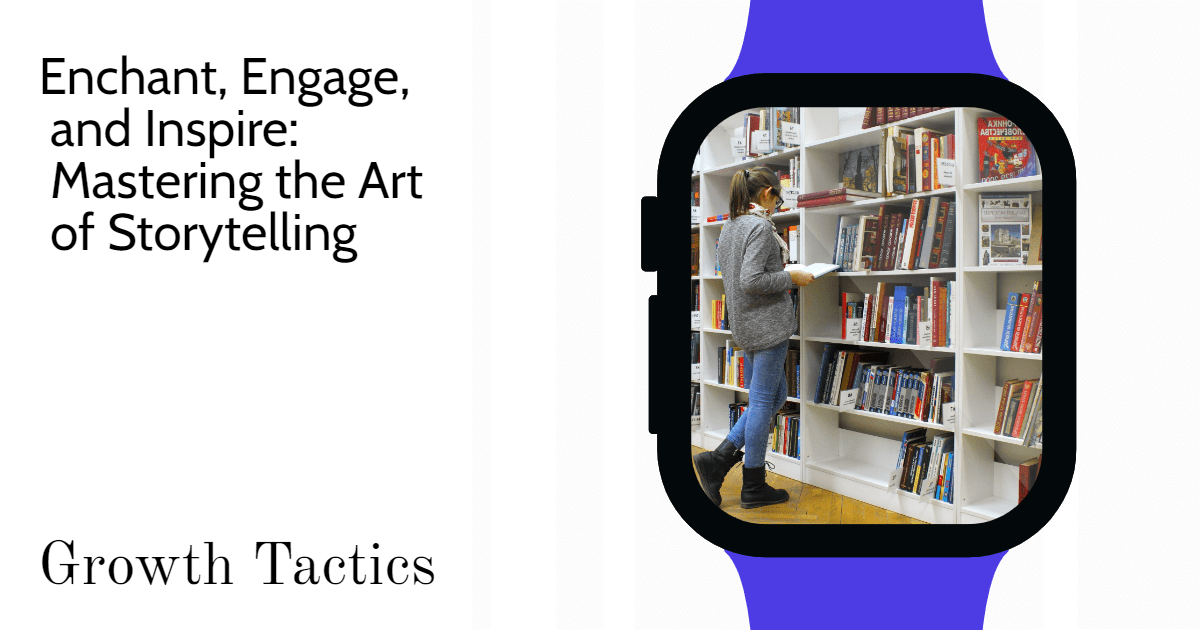Ever wonder what makes some people so captivating when they speak? It’s their knack for telling stories. We all have this power inside us. It’s just waiting to be unleashed.
Think about it. Your experiences, your ups and downs, your wins and losses, they’re all part of your unique story. And guess what? People want to hear it.
So, are you ready to master the art of storytelling? It’s time to dig deep and find those tales that only you can tell. Don’t worry if you’re not sure where to start. We’ll figure it out together.
Jump To Section
Why Being a Good Storyteller Matters
Before we get into how to tell a great story let’s briefly discuss why it’s important.
Connects You with Others
Good stories bridge gaps between people. They help us understand each other better. When you share your experiences, you’re not just talking, you’re building relationships.
Makes Your Message Stick
Facts and figures are important, but stories make them memorable. Think about it. Which do you remember better: a list of stats or a compelling story?
Inspires Action
Stories have power. They can move people to act. As a leader, your stories can motivate your team to push harder and reach higher.
Builds Trust
When you open up and share your stories, people see the real you. This honesty creates trust. And trust is the foundation of strong leadership.
Helps You Stand Out
In a world full of noise, a good story cuts through the clutter. It makes you and your ideas unforgettable.

Foundational Elements of Storytelling
Now that you understand why storytelling is so important, we’ll get into the foundational elements of storytelling.
To tell a truly compelling story, it is essential to have a strong foundation. This begins with understanding your audience. Who are they? What do they care about? What motivates them? By answering these questions, you can tailor your story to resonate with your audience and ensure it is impactful and engaging.
Next, it is important to identify the core message that you want to convey. What is the main point of your story? What do you want your audience to take away from it? This message should be clear and concise and should guide the rest of your storytelling.
Finally, any story must have a clear beginning, middle, and end. The beginning should grab your audience’s attention and set the stage for what’s to come. The middle should develop the story and build tension or emotion, while the end should provide a satisfying conclusion and tie up any loose ends.
By focusing on these foundational elements, you can ensure that your story is well-crafted and resonates with your audience. With a strong foundation in place, you can begin to explore techniques for enchanting, engaging, and inspiring your audience through storytelling.
Enchanting Your Audience
Enchantment is a crucial aspect of storytelling that captivates your audience and immerses them in the world you’ve created. By enchanting your audience, you can make your stories memorable and impactful. Here are three key techniques to enchant your audience:
Paint a Picture with Your Words
Words have power. They can make your story come alive. Think about how you can use words to show, not just tell. What words can you use to make your audience feel like they’re right there in your story? Try using words that appeal to all the senses. This way, your audience can see, hear, and even smell what’s happening in your story.
Create Characters People Care About
Everyone loves a good character. Think about the people in your life. What makes them unique? Use these ideas to create characters in your stories. Give your characters hopes, fears, and dreams. Make them feel real. When your audience can relate to your characters, they’ll care about what happens to them.
Keep Your Audience Guessing
Ever watched a movie where you couldn’t wait to see what happened next? That’s what you want for your story. Keep your audience on their toes. Throw in some surprises. Create problems for your characters to solve. When you keep things interesting, people will want to hear more.
By focusing on these techniques, you can enchant your audience and make your stories more captivating and memorable. When you successfully enchant your audience, you’re well on your way to creating a story that engages and inspires.
Engaging Your Audience
To truly engage your audience, it is essential to create an immersive experience that keeps them invested in your story. Here are three key techniques to increase audience engagement:
Tap into Feelings: Make ‘Em Care
We all have feelings, right? Use that in your story. Think about love, friendship, or even fear. Make your characters feel these things. When they do, your audience will feel them too. It’s like magic, suddenly, your audience is right there in the story with you.
Let Your Characters Talk: Make It Real
Ever eavesdropped on a conversation? That’s what good dialogue feels like. Let your characters talk to each other. Make it sound real. When they chat, we learn about who they are and what they want. It’s like peeking into their lives. This makes your story feel alive and keeps people wanting more.
Add Some Laughs: Keep It Fun
Life isn’t always serious, and neither should your story be. Throw in some funny moments. Maybe a character says something clever, or a silly situation pops up. These light moments balance out the heavy stuff. Plus, they make your characters more likable. Who doesn’t love someone who can make them laugh?
By focusing on these techniques, you can create an engaging experience that keeps your audience invested in your story. When you successfully engage your audience, you pave the way for your story to inspire and leave a lasting impact.
Inspiring Your Audience
To truly inspire your audience, you must go beyond simply telling a story. You need to create a powerful emotional connection with your audience that moves them to action. Here are three key techniques to inspire your audience:
Open Up: Share Your Story
Remember that time you messed up big time? Or when you faced a huge challenge? Share it. When you open up about your struggles, people listen. They see themselves in your story. It’s like holding up a mirror and saying, “Hey, I’ve been there too.”
When you talk about how you bounced back, it gives others hope. It shows them they can do it too. Your honesty can be the push someone needs to take that first step towards change.
Call Them to Action: Show Them How to Help
Ever felt fired up after hearing a great speech, but didn’t know what to do next? Don’t leave your audience hanging like that. Give them a clear next step. Maybe it’s donating to a cause. Or signing a petition. Or even just making a small change in their daily routine.
Whatever it is, make it clear and doable. Break it down into simple steps. Show them how their action, no matter how small, can make a real difference. When people see a clear path forward, they’re more likely to take that first step.
Spread Hope: Show What’s Possible
The world can seem pretty dark sometimes. But your story can be a beacon of hope. Show your audience that change is possible. Share examples of people who’ve beaten the odds. Talk about small actions that led to big changes.
Remember, hope is contagious. When you believe in the power of change, others will too. Your faith in what’s possible can inspire others to dream big and take action.
By focusing on these techniques, you can create a story that not only entertains and engages but also inspires and motivates your audience. When you successfully inspire your audience, you have the power to make a positive impact on the world.
Practical Exercises and Techniques
To enhance your storytelling skills and engage your audience effectively, it’s essential to practice and refine your craft. Here are three practical exercises and techniques to help you develop your storytelling abilities:
Developing your storytelling voice
To find your unique storytelling voice, experiment with different writing styles and techniques. Begin by writing short stories, personal essays, or even blog posts, and pay attention to which style resonates with you the most. Additionally, read works from various authors and genres, and take note of the elements you enjoy. Incorporate those elements into your writing, and over time, your distinct voice will emerge.
Exercise: Set aside 15-30 minutes each day to write about any topic that interests you. Experiment with different tones, perspectives, and writing styles until you discover your unique voice.
Practicing the art of improvisation
Improvisation can help you develop your storytelling skills by allowing you to think quickly and creatively. Improvisation exercises can be done alone or with a partner and can help you learn how to adapt, create, and collaborate on the fly.
Exercise: Try the “Yes, and…” improvisation exercise. Begin by crafting a story, either in writing or verbally. If working with a partner, have them add a new element or plot twist to the story. Your task is to accept the new element and continue the story by saying “Yes, and…” and expanding on the new idea. This exercise teaches you to adapt to new ideas and incorporate them into your narrative seamlessly.
Experimenting with different storytelling formats
Experimenting with various storytelling formats can help you discover new ways to engage your audience and convey your message effectively. By exploring different formats, you can learn to adapt your storytelling style to suit different platforms and audiences.
Exercise: Choose a single story or theme and rewrite it in three different formats, such as a short story, a poem, and a screenplay. Analyze the unique challenges and benefits of each format, and notice how the format affects the way you tell the story.
By incorporating these exercises and techniques into your routine, you will develop your storytelling skills and learn how to captivate, enchant, and inspire your audience effectively.
Real-World Applications of Storytelling
Storytelling is a powerful tool that can be utilized in various real-world applications. Here are three examples of how storytelling can be applied in different contexts:
Writing and publishing
Storytelling is a fundamental aspect of writing and publishing. A compelling story can captivate readers, evoke emotions, and leave a lasting impact. By incorporating storytelling techniques such as character development, plot structure, and descriptive language, writers can create immersive experiences for their readers. Additionally, storytelling is essential in the publishing industry, where book blurbs and synopses serve as a way to engage potential readers.
Public speaking and presentations
Storytelling can also be used in public speaking and presentations to engage and inspire audiences. By incorporating personal anecdotes and relatable stories, speakers can capture their audience’s attention and create emotional connections. Additionally, storytelling can be used to convey complex ideas and information in a more digestible and memorable way. By using storytelling techniques such as metaphors, analogies, and examples, speakers can make their presentations more impactful and memorable.
Marketing and branding
Storytelling is a critical component of marketing and branding. By creating a compelling brand story, companies can differentiate themselves from their competitors and create emotional connections with their customers. A brand story can also help communicate a company’s values, mission, and unique selling proposition. Additionally, storytelling is crucial in advertising, where commercials and social media campaigns rely on narratives to engage and persuade their audiences.
Expert Advice and Insights to Master the Art of Storytelling
Learning from Successful Storytellers
To become a better storyteller, study the works of successful storytellers across different formats. Analyze their techniques, narrative structures, and character development. Reading interviews and watching talks by these storytellers can provide insights into their creative process and experiences.
Overcoming Common Storytelling Challenges
1. Overcoming Writer’s Block
Develop a regular writing routine, set achievable goals, and experiment with different brainstorming techniques. If you’re stuck, take a break and do something unrelated to writing to recharge your creative energy.
2. Maintaining a Consistent Tone
Pay close attention to your choice of words, sentence structure, and rhythm. Reading your work aloud can help you identify inconsistencies in tone.
3. Keeping the Audience Engaged
Ensure your story has a clear structure, relatable characters, and a strong emotional hook. Additionally, vary the pacing and incorporate suspenseful elements to maintain interest.
Continuously Improving and Refining Your Craft
1. Reading Widely
Expand your understanding of different storytelling techniques and strategies by reading across various genres and styles.
2. Seeking Feedback
Share your work with friends, writing groups, or online forums to gain valuable feedback and constructive criticism.
3. Attending Workshops and Courses
Participate in writing workshops and courses to learn new techniques, receive expert guidance, and network with fellow storytellers.
4. Practicing Regularly
To truly master the art of storytelling you need to practice. Set aside dedicated time each day to write and experiment with different storytelling formats and styles.
By focusing on these strategies, you will be well on your way to becoming a master storyteller, capable of captivating and engaging audiences with your compelling narratives.
Conclusion
In conclusion, mastering the art of storytelling is a journey filled with learning, growth, and continuous improvement. As you absorb the wisdom of successful storytellers, tackle common challenges, and refine your craft, remember that your unique voice and perspective have the power to enchant, engage, and inspire your audience.
Embrace your passion for storytelling and use it to create captivating narratives that resonate with readers and listeners alike. By dedicating yourself to this journey, you will not only refine your storytelling abilities but also leave a lasting impact on the hearts and minds of your audience. So, go forth and weave your tales, for the world is ready to be captivated by your stories.
Did you enjoy this article on how to master the art of storytelling? please share and subscribe below.








